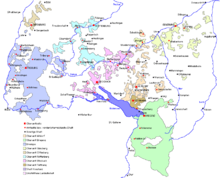Oberamt Breisgau
The Oberamt Breisgau , based in Freiburg im Breisgau , was created in January 1754 as an intermediate instance between the local authorities and the provincial government of Upper Austria .
Territory of the Oberamt
The area of the Oberamt extended from Herbolzheim and Triberg in the north via Breisach, Krozingen and Waldshut to Laufenburg and Rheinfelden including today's Fricktal south of the Rhine. On the eastern edge of the Black Forest, the cities of Villingen and Bräunlingen belonged to it.
The associated ecclesiastical lordships, cities and cameramen are listed in the article Breisgauer Land estates . A list of chivalrous places can be found under members of the knighthood in Breisgau .
Duties of the senior office
Only the six Breisgau cameramen were administered directly by the Habsburg rule. The rulers of the clergy and aristocratic classes were administered by them themselves and the cities also had self-administration rights. The term administration is to be seen here in a broader sense including fiscal administration and the case law of the first instance. In order to implement the requirements of the state rulership, supervision of the local authorities was required. The area of the province of Vorderösterreich was too large, too fragmented and included areas with very different historical rights, so that this supervision by the provincial authorities could not be carried out.
In the special case of the Breisgau Oberamt with its seat at the seat of the provincial authorities, the provincial authorities took over the duties of the Oberamt themselves after an unsuccessful attempt with their own district chief.
In addition to the sovereign administration, there was the Breisgauer land estates as an organization of the land estates for the exercise of their rights of participation in the administration of the Breisgau.
history
On April 29, 1752, “Empress” Maria Theresa issued a resolution on the restructuring of the Vorlande, which provided for a separate higher authority for the Vorlande, which had previously been subordinate to the authorities in Innsbruck . On January 1, 1753, the new higher authorities in Constance (representation and chamber = general and financial administration) and Freiburg i.Br. (Government = judicial authorities) their work.
In February 1753 the previous camera offices in Waldkirch (Kameralherrschaft Kastelberg) and Laufenburg were established as higher offices for the lower and upper Breisgau respectively. But already in January 1754 this organization was changed again and an upper office was established for the entire Austrian Breisgau in Freiburg. In the province of Vorderösterreich, the term Oberamt was used instead of the term Kreisamt, which is customary in the other Habsburg states . As Kreishauptmann was Christoph Anton von Schauenburg used. Schauenburg was deposed as early as 1759 because, on the one hand, his personal behavior led to hostility and, on the other hand, he was also the target of attacks that actually applied to the new absolutist - and thus anti-class - form of government of the Viennese court. In 1762 von Schauenburg was sentenced to three years imprisonment. In 1759, the higher authorities previously located in Constance were relocated to Freiburg to improve the efficiency of the administration, where the entire higher authorities of the province were now united. The higher authority now simultaneously performed the tasks of the intermediate authority Oberamt Breisgau .
With the state order for the Duchy of Modena-Breisgau of October 1, 1803, a state office was created for the administration, which replaced the upper office. At the beginning of 1806, due to different interpretations of the Peace Treaty of Preßburg, there was a short-term Württemberg occupation of eastern Breisgau . When the Duchy of Modena-Breisgau was handed over to the Electorate of Baden on April 15, 1806, a Baden “government and cammer” was initially set up in Freiburg. As a result, the former Oberamt was incorporated into the administrative structure of Baden .
literature
- Franz Quarthal : Front Austria . In: Meinrad Schaab , Hansmartin Schwarzmaier (ed.) U. a .: Handbook of Baden-Württemberg History . Volume 1: General History. Part 2: From the late Middle Ages to the end of the old empire. Edited on behalf of the Commission for Historical Regional Studies in Baden-Württemberg . Klett-Cotta, Stuttgart 2000, ISBN 3-608-91948-1 , pp. 587-780, in particular 7. The Province of Vorderösterreich 1753-1803 , pp. 756-780.
- Franz Quarthal: On the history of the administration of the Austrian foreland. In: Franz Quarthal, Birgit Dürr, Georg Wieland (eds.): The organization of the authorities in Upper Austria from 1753 to 1805: and the officials in administration, justice and education. Konkordia, Bühl / Baden 1977 (publication by the Alemannisches Institut, 43), pp. 43–162, doi: 10.18419 / opus-5292
- Otto Stolz : The relationship between the Upper Austrian provinces and the sovereign governments in Innsbruck and Vienna. In: Front Austria. A historical geography. Edited by the Alemannic Institute under the direction of Friedrich Metz. Rombach, Freiburg i. Br. 1958; 2nd, enlarged and improved edition. 1967, pp. 111-121
Individual evidence
- ↑ Entry on zum.de/Faecher
- ↑ see Quarthal 1977, p. 42
- ↑ Kur-Baden Government Gazette No. 12 of May 13, 1806
